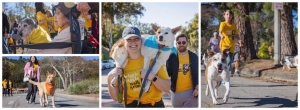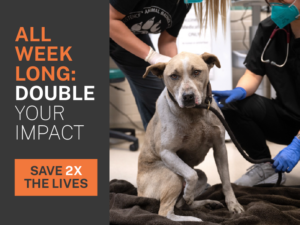Pasadena Humane’s rules 101 when greeting a dog

More than 1,000 animal lovers joined Pasadena Humane at the 25th annual Wiggle Waggle Walk and Run on April 2 at Brookside Park in Pasadena. The organization raised over $240,000 to help fund lifesaving programs and services for the animals. (Photo by Lori Fusaro/Pasadena Humane)
I like to think of our Wiggle Waggle Walk and Run as a big dog party in the park. Dogs of all ages, breeds and sizes attend with their guardians. I quickly spotted massive Great Danes, tiny Yorkies, and everything in between.
With so many cute dogs around, it was tempting to reach down and pet every one of them. But working in animal welfare, I’ve learned to take it slowly when meeting new dogs. Not only does this help to keep dogs happy and show respect for their boundaries…it’s also one of the easiest ways to prevent bites.
When greeting a new dog, there are six important steps to follow:
- Keep your distance and approach slowly. Refrain from running up or rushing a dog and keep your arms and hands at your side.
- Always ask the dog’s owner for permission to pet their pup.
- If given the green light, angle your body to the side and keep your eyes looking sideways at the dog. Do not approach the dog head-on or make direct eye contact, which can be intimidating for a dog. For smaller dogs, you might carefully kneel to their level to avoid intimidation, although remember kneeling will put your face at bite level.
- Next, wait for the dog to approach you. Or, if the owner agrees, offer the dog a tasty treat.
- If the dog comes near and looks relaxed, give them a gentle pet on the chest, shoulders or under the chin. Avoid reaching over the dog’s head, which may scare the dog.
- If the dog stays within arm’s reach after you’ve petted them a few times, that’s your invitation to keep petting. If not, it’s time to give the dog some space.
You may be thinking, what about “the sniff test”? For decades, it’s been commonly taught that you should greet a new dog by extending your hand to let them sniff. It’s best to keep your hand balled into a fist at your side and allow the dog to approach you to sniff if interested. Dogs have an extraordinary sense of smell, so they’ve already detected your scent long before you are close enough for petting.
Also, having a stranger reach for their face can be quite threatening for a dog. You are forcing an interaction with the dog rather than giving them a choice to greet you. Some dogs may even snap or bite at strange hands coming towards them.
It’s especially important to teach children how to safely greet a dog. More than 2 million children are bitten by dogs in the United States each year. Children should also be taught to “Be a Tree” if approached by a loose dog. That means stand still, look down at the ground (not at the dog), keep your arms to your side and hands folded together in front of you.
While many dogs, like my Sueshi, enjoy meeting new people, there are plenty who would prefer to keep their distance. It’s always okay to say no when someone asks to pet your dog.
Understand your dog’s needs and communicate those needs to anyone who approaches.
Visit our online behavior resource library for more tips or consider signing your pup up for our next session of training classes. Learn more at pasadenahumane.org/behavior
Dia DuVernet is president and CEO of Pasadena Humane.
This blog post originally appeared as a column in the Pasadena Star-News on April 7, 2023.



